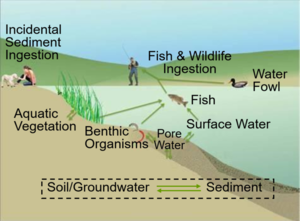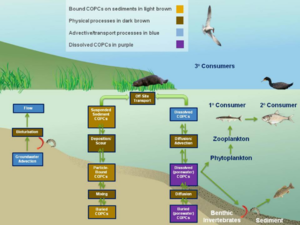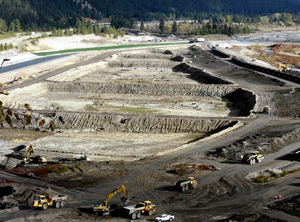User:Debra Tabron/sandbox
Sediments are unconsolidated particulate materials found at the bottom of natural and manmade surface water bodies. They may include clay, silt, sand, gravel, decaying organic matter, or shells. Discharge of contaminants to surface water can result in contamination of sediments and potentially adverse impacts to receptors including Benthic and water-column invertebrates, fish, wildlife, plants, and human populations. Contaminant sources include contaminated wastewater, surface water runoff, stormwater discharge, or groundwater, atmospheric deposition, and spills and releases. Common contaminants include petroleum products, polychlorinated biphenyls (PCBs), polycyclic aromatic hydrocarbons (PAHs), dioxins, pesticides, metals, radionuclides, and excess nutrients[1][2].
This article provides a brief introduction to the major topics associated with contaminated sediment management and remediation. It is not intended to be an exhaustive treatise on the subject of contaminated sediments, but rather to be a curated resource on key aspects of contaminated sediments that have seen major innovations in recent years. It also provides links to more in-depth enviro.wiki discussions on the key topics as well as links to major resources on the subject of contaminated sediments.
Related Article(s):
- Contaminated Sediments - Passive Sampling (Coming soon)
- Contaminated Sediments - In Situ Treatment (Coming soon)
- Contaminated Sediments - Capping (Coming soon)
CONTRIBUTOR(S):
Key Resource(s):
- Website ITRC - Contaminated Sediments Remediation[3]
- USEPA – Sediment Risk Management Principles[4]
- USEPA - Superfund Contaminated Sediments: Guidance and Technical Support[1]
Introduction
Sediments are unconsolidated particulate materials found at the bottom of natural and manmade surface water bodies. They may include clay, silt, sand, gravel, decaying organic matter, or shells. Discharge of contaminants to lakes, rivers, and estuaries can result in contamination of the underlying sediment and potential adverse impacts to critical receptors including benthic and water-column invertebrates, fish, wildlife, plants and human populations. Past or ongoing sources of contaminants include industrial and municipal wastewater, runoff from contaminated terrestrial sites, stormwater discharges, and atmospheric deposition. Contaminated sediments are often located in sensitive aquatic environments and sometimes may require corrective measures to reduce exposure to human and ecological receptors[2].
In most cases, the primary contaminants of concern in sediments are relatively immobile and long-lived. This includes petroleum products, polychlorinated biphenyls (PCBs), polycyclic_aromatic_hydrocarbons_(PAHs), dioxins, metals (mercury, copper, cadmium, lead, nickel, zinc, tin), radionuclides, and excess nutrients[2]. Some of the contaminants (like metals and PAHs) primarily pose a risk to benthic organisms present in the sediments, while the bioaccumulative chemicals (PCBs, dioxins) are more likely to impact higher trophic organisms such as fish and humans.
Sediment Risk Assessment and Management


Effective risk management and remediation of contaminated sediments requires an understanding of how contaminants are released from sediment, transported, and taken up by receptors[2]. A clear understanding of important exposure pathways based on site-specific information is needed for the formulation of a robust site conceptual model. Figure 1 illustrates typical transport pathways between sediment and receptors in a freshwater system. A substantial portion of the total mass of a contaminant present in sediment is often not available to potential receptors due to a variety of “…physical, chemical, and biological interactions that determine the exposure of plants and animals to chemicals associated with soils and sediments” (National Research Council, 2003). As a result, contaminant “bioavailability” must be incorporated into Conceptual Site Models (CSMs) and risk assessments[2].
Important processes controlling contaminant bioavailability include physical (advection/diffusion, resuspension/deposition, burial, bioturbation, and ebullition/gas transport), chemical (sorption/desorption, transformation/degradation, oxidation/reduction) and biological (uptake, bioconcentration or bioaccumulation, biotransformation)[2]. Important physical transport and ecological receptor processes for contaminants of potential concern (COPCs) in a typical freshwater ecosystem are illustrated in Figure 2.
Risk Management and Remedy Selection
Risk management at contaminated sediment sites typically follows the guidance established by the U.S. Environmental Protection Agency (USEPA) Superfund program. Once the nature and magnitude of risk has been established, several options exist for the management of the risk including institutional controls such as site access control or fish consumption advisories, relying on the natural process of attenuation, and/or active remedies of the contaminated sediments. The USEPA has developed technical guidance to facilitate characterization, risk management, and remediation of contaminated sediment sites and encourage national consistency in these processes.
During selection of a remedy to address contaminated sediment, the USEPA recommends a risk-based approach that accounts for short-term and long-term risks. In addition, the remedy selected must maintain consistency with the National Oil and Hazardous Substances Pollution Contingency Plan’s nine remedy selection criteria set forth in 40 CFR Part 300.430 as follows:
- Protection of human health and the environment;
- Compliance with Applicable or Relevant and Appropriate Requirements;
- Long-term effectiveness and permanence;
- Toxicity, mobility or volume reduction through treatment;
- Short-term effectiveness;
- Implementability;
- Cost;
- State agency acceptance; and
- Community acceptance.
The Interstate Technology and Regulatory Council (ITRC) has also developed a remedy selection framework to help project managers evaluate remedial technologies and develop alternatives based on site-specific data. This framework includes:
- Reviewing the site characteristics,
- Identifying and mapping remedial zones,
- Screening remedial technologies,
- Evaluating remedial technologies,
- Developing remedial action alternatives, and
- Evaluating remedial action alternatives[3].
Remedial Technologies

Commonly employed technologies for sediment remediation include monitored natural recovery, enhanced monitored natural recovery, in situ treatment, capping, and removal[3].
Monitored natural recovery (MNR) is defined as a remediation practice that relies on natural processes to decrease chemical contaminants in sediment to acceptable concentrations within a reasonable time frame (National Research Council 2000). Enhanced MNR (EMNR) applies material or amendments to enhance these natural recovery processes (such as the addition of a thin-layer cap or a carbon amendment). Parallel natural or enhanced processes, taken together with observed and predicted reductions of contaminant concentrations in fish tissue, sediments, and water, provide multiple lines of evidence to support the selection of MNR/EMNR as the primary remedial strategy[5]. Important processes to consider in assessments of MNR/EMNR include contaminant burial, dispersion, sorption, precipitation, and chemical, biological and radioactive transformations[3].
In situ treatment commonly involves the addition of treatment amendments to accelerate contaminant removal and/or immobilize the contaminant[3]. Amendments that have been considered for sediment treatment include organophilic clay, zeolites, bauxite, iron oxide/hydroxide, apatite, and zero valent iron[6]. However, the most common approach is addition of activated carbon (AC) as a thin-layer cap or incorporated into the sediment[7]. For additional information on in situ treatment, see Contaminated Sediments - Activated Carbon.
Capping is the process of placing a clean layer of sand, sediments or other material over contaminated sediments in order to mitigate risk posed by those sediments[3]. The cap can include geotextiles and armoring layers to improve stability and enhance habitat. For additional information on capping, see Contaminated Sediments - Capping.
Removal (dredging or excavation) physically removes the contaminated sediment from the ecosystem and is most effective for hot spots and major sources but may be less effective for overall risk reduction because of resuspension and residual contamination[3]. Once removed, the contaminated sediments are treated or disposed at an offsite location. Figure 3 shows sediment excavation at the Milltown Reservoir Sediments Superfund Site.
References
- ^ 1.0 1.1 U.S. Environmental Protection Agency (USEPA), 2019. Superfund: Contaminated Sediments website
- ^ 2.0 2.1 2.2 2.3 2.4 2.5 ITRC, 2011. Incorporating bioavailability considerations into the evaluation of contaminated sediment sites. [[media:2011-ITRC_incorporating_bioavailability_Considerations_into_the_Evaluation_of_Contaminated_Sediment_Sites.pdf| Report.pdf]
- ^ 3.0 3.1 3.2 3.3 3.4 3.5 3.6 ITRC, 2014. Contaminated Sediments Remediation Website
- ^ USEPA, 2002. Principles for Managing Contaminated Sediment Risks at Hazardous Waste Sites. OSWER Directive 9285.6–08. Report.pdf
- ^ Magar, V.S., Chadwick, D.B., Bridges, T.S., Fuchsman, P.C., Conder, J.M., Dekker, T.J., Steevens, J.A., Gustavson, K.E. and Mills, M.A., 2009. Monitored natural recovery at contaminated sediment sites. Environ International Corp Arlington Va. Report.pdf
- ^ O'Day, P.A. and Vlassopoulos, D., 2010. Mineral-based amendments for remediation. Elements, 6(6), pp.375-381 doi: 10.2113/gselements.6.6.375
- ^ Ghosh, U., Luthy, R.G., Cornelissen, G., Werner, D. and Menzie, C.A., 2011. In-situ sorbent amendments: a new direction in contaminated sediment management. doi: 10.1021/es102694h